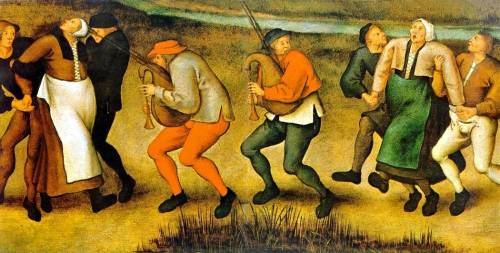
Yes. You read that right. Here we have the weirdest, funniest and freakiest unsolved mystery I’ve come across in the year and a half that I’ve been writing Behind The Curtain…
I remember reading about this a few years ago and thinking, nah, it can’t be true. It’s ridiculous. Yet, outlandish as it sounds, the “dancing plague” that occurred in mainland Europe between the 14th and 17th centuries was well documented. Also known as “dancing mania” or “choreomania” (haha!), it affected men, women and children. Basically groups of people, sometimes thousands at a time, would dance erratically until they collapsed from exhaustion — or died!
There were a number of outbreaks, but the most famous took place in Strasbourg in 1518. A woman named Frau Troffea began dancing enthusiastically in a street and proceeded to do so for 4 to 6 days. Within a week, 34 others had joined in. Within a month, 400 people were dancing continuously until some of them died from exhaustion, heart attacks and strokes.
According to historical sources, local physicians ruled out supernatural causes and believed that the dancing plague was a “natural disease” caused by “hot blood”. They believed that the cure was to simply dance more. Authorities therefore encouraged more dancing, opening special dancing halls and stages and paying musicians to keep them boogying.
Public sex, colourful outfits and wooden sticks: yes, it gets weirder
Author and historian Robert Bartholomew investigated dancing mania and yielded ever weirder details about the phenomenon.
He discovered that some victims wore strange, colourful clothes while dancing and waved wooden sticks about. Others paraded around naked and made obscene gestures. Some sang, laughed or cried while dancing. Some pretended to be animals, hopping and leaping about like frogs and rabbits. And some just decided to get down and dirty with each other in front of everyone.
Oh, and some people became violent whenever they saw the colour red.
What on Earth caused this madness?
Unfortunately the world’s historians and physicians cannot agree on the cause of what Wiki calls a “social phenomenon”, so I still don’t know what to make of it.
Generally dancing mania is thought to be one of the earliest-recorded forms of mass hysteria. Sources agree that the participants were psychologically disturbed and often seemed entranced and literally unable to control themselves. Some have put this down to ergot poisoning, which causes hallucinations and convulsions (but doesn’t account for all the symptoms).
Historian John Waller says it was stress-induced psychosis, that because of famine, disease, poverty and starvation, the stress on the people was intolerable and so a mass psychological illness resulted. He says that the particular symptom of dancing might’ve been inspired by superstition and in particular, a Christian legend about St. Vitus. This legend warned people that if they incited the wrath of St. Vitus, he would send down a plague of compulsive dancing.
Then there’s the conspiracy theory that all the dancing outbreaks were staged. It’s argued that the dances may have been rituals organised by religious cults and the appearance of uncontrollable dancing by all or some of the participants was faked. Others argue that the dances were deliberately planned, but that some ordinary people joined in out of fear or because they wished to copy everyone else.
Another possible cause is that the witches of Salem, Massachusetts, cast a spell on the dancers by singing “I Put a Spell on You” and enchanting them to “dance until they die”.
Oh no, wait. That’s Hocus Pocus. 😉
Next week: the world’s most mysterious manuscript

Ah good old St. Vitus! The on-bringer of epileptic seizures. Interesting post! Thanks for sharing it.
LikeLike
You’re welcome! I’m glad you enjoyed it and thanks for commenting! 😄
LikeLiked by 1 person